#achaemenid persia
Text

return trip to the Throne Hall at Persepolis
#nanashi mumei#hololive#holocouncil#persepolis#achaemenid persia#needed a good ol hatching exercise to lift my spirits...#comic#wlart#williamleonard
326 notes
·
View notes
Note
Hello Dra. Reames, I want to know more about Persia, what books can you recommend?

These would both be a good place to start. Solid overviews. One on the left will be my new Persia textbook for my ANE class. I'd start there, then move on to Lloyd's. Wiesehoerffer also has a good intro book on Persia, which I used before Brosius. After those three, then you might want to dive into longer works (now in English) by Pierre Briant (From Cyrus to Alexander, and Darius in the Shadow of Alexander), as well as Amelie Kuhrt's The Persian Empire: A Corpus of Sources from the Achaemenid Period. These last three are MASSIVE, but they're comprehensive.
Have fun! And, if you read German or French...there are a LOT of texts on Persia to choose from. Some of the best work on Persia is being done in German and French, actually.
#Classics#asks#ancient Persia#Achaemenid Persia#books in English on ancient Persia#Pierre Briant#Amelie Kuhrt#Maria Brosius#Josef Wiesehoerffer#Lloyd Llewellyn-Jones
18 notes
·
View notes
Text
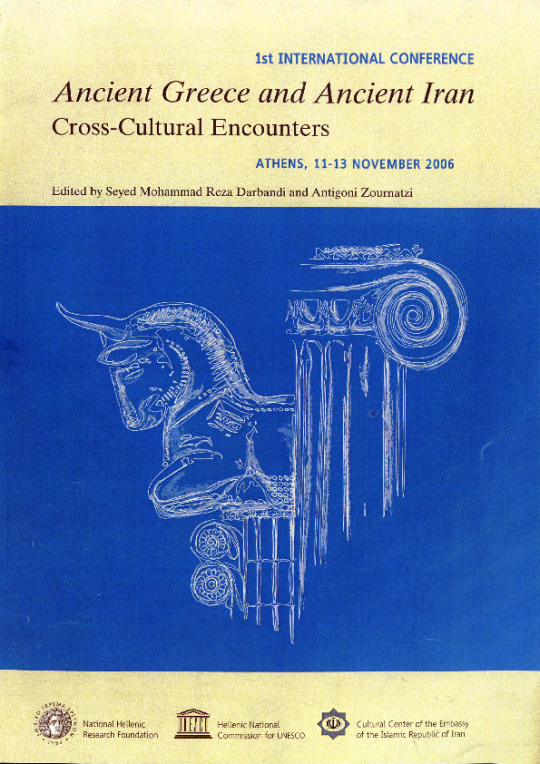
Ancient Greece and Ancient Iran: Cross‐Cultural Encounters
1st INTERNATIONAL CONFERENCE (ATHENS, 11‐13 NOVEMBER 2006)
Edited by Seyed Mohammad Reza Darbandi and Antigoni Zournatzi
National Hellenic Research Foundation
Cultural Center of the Embassy of the Islamic Republic of Iran in
Athens
Hellenic National Commission for UNESCO
Athens, December 2008
Description
The extraordinary feats of conquest of Cyrus the Great and Alexander the Great have left a lasting imprint in the annals of world
history. Successive Persian and Greek rule over vast stretches of territory from the Indus to the eastern Mediterranean also created an
international environment in which people, commodities, technological innovations, as well as intellectual, political, and artistic ideas could circulate across the ancient world unhindered by ethno-cultural and territorial barriers, bringing about cross-fertilization between East and West. These broad patterns of cultural phenomena are illustrated in twenty-four contributions to the first international conference on ancient Greek-Iranian interactions, which was organized as a joint Greek and Iranian initiative.
Contents
Preface (Ekaterini Tzitzikosta)
Conference addresses (Dimitrios A. Kyriakidis, Seyed Taha Hashemi Toghraljerdi, Mir Jalaleddin Kazzazi, Vassos Karageorghis,
Miltiades Hatzopoulos, Seyed Mohammad Reza Darbandi, Massoud Azarnoush, David Stronach)
Introduction (Seyed Mohammad Reza Darbandi and Antigoni Zournatzi)
Europe and Asia: Aeschylus’ Persians and Homer’s Iliad (Stephen Tracy)
The death of Masistios and the mourning for his loss (Hdt. 9.20-25.1) (Angeliki Petropoulou)
Magi in Athens in the fifth century BC? (Kyriakos Tsantsanoglou)
Hājīābād and the dialogue of civilizations (Massoud Azarnoush)
Zoroastrianism and Christianity in the Sasanian empire (fourth century AD) (Sara Alinia)
Greco-Persian literary interactions in classical Persian literature (Evangelos Venetis)
Pseudo-Aristotelian politics and theology in universal Islam (Garth Fowden)
The system Artaphernes-Mardonius as an example of imperial nostalgia (Michael N. Weiskopf)
Greeks and Iranians in the Cimmerian Bosporus in the second/first century BC: new epigraphic data from Tanais (Askold I.
Ivantchik)
The Seleucids and their Achaemenid predecessors: a Persian inheritance? (Christopher Tuplin)
Managing an empire — teacher and pupil (G. G. Aperghis)
The building program of Cyrus the Great at Pasargadae and the date of the fall of Sardis (David Stronach)
Persia and Greece: the role of cultural interactions in the architecture of Persepolis— Pasargadae (Mohammad Hassan Talebian)
Reading Persepolis in Greek— Part Two: marriage metaphors and unmanly virtues (Margaret C. Root)
The marble of the Penelope from Persepolis and its historical implications (Olga Palagia)
Cultural interconnections in the Achaemenid West: a few reflections on the testimony of the Cypriot archaeological record
(Antigoni Zournatzi)
Greek, Anatolian, and Persian iconography in Asia Minor: material sources, method, and perspectives (Yannick Lintz)
Imaging a tomb chamber: the iconographic program of the Tatarlı wall paintings (Lâtife Summerer). Appendix: Tatarli Project:
reconstructing a wooden tomb chamber (Alexander von Kienlin)
The Achaemenid lion-griffin on a Macedonian tomb painting and on a Sicyonian mosaic (Stavros A. Paspalas)
Psychotropic plants on Achaemenid style vessels (Despina Ignatiadou)
Achaemenid toreutics in the Greek periphery (Athanasios Sideris)
Achaemenid influences on Rhodian minor arts and crafts (Pavlos Triantafyllidis)
Historical Iranian and Greek relations in retrospect (Mehdi Rahbar)
Persia and Greece: a forgotten history of cultural relations (Shahrokh Razmjou)
The editors
Seyed Mohammad Reza Darbandi is General Director of Cultural Offices of the Islamic Republic of Iran for Europe and the Americas.
Antigoni Zournatzi is Senior Researcher in the Research Centre for Greek and Roman Antiquity, National Hellenic Research
Foundation. Her work focuses on the relations between Achaemenid Persia and the West.
The whole volume can be found as pdf on:
7 notes
·
View notes
Text

Gold daric of the Achaemenid Persian Empire, minted at Sardis on the Lydo-Milesian standard. On the obverse, a running king or hero, armed with spear and bow; on the reverse, an incuse punch. Artist unknown; ca. 420-375 BCE (reigns of Xerxes II to Artaxerxes II). Photo credit: Classical Numismatic Group, Inc. http://www.cngcoins.com
#classics#tagamemnon#Persian Empire#Achaemenid Empire#Achaemenid Persia#art#art history#ancient art#Persian art#coins#ancient coins#Persian coins#numismatics#ancient numismatics#daric
82 notes
·
View notes
Text
If he’s not:
A friend of the truth and an enemy of the lie
Good with spear and bow
On foot and on horseback
In control of his anger and impulses
Gardening
An Achaemenid Persian nobleman
Then, I don’t want him. 🙄
#get me an Achaemenid boyfriend 2023#my friend says so#smh I love Achaemenid Persian history too much#Achaemenid Persia#history#aubade’s history nerd hour#come on Persian nobles were kinda cool
5 notes
·
View notes
Photo
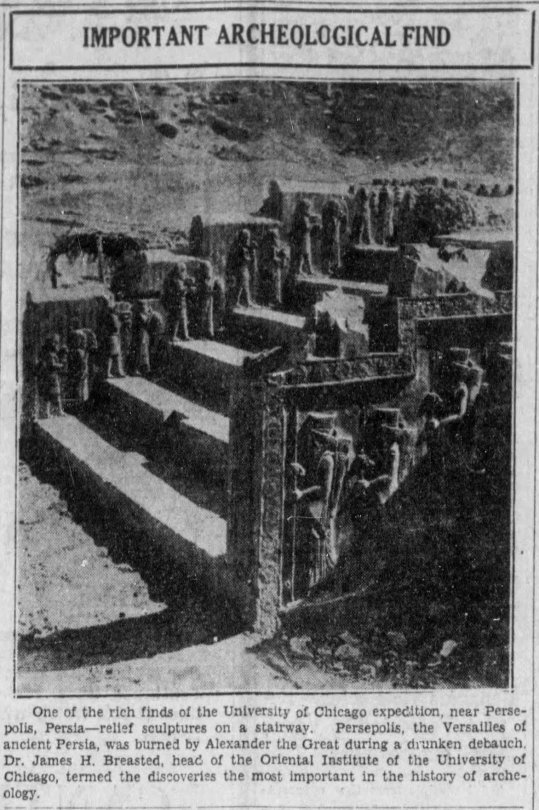
“IMPORTANT ARCHEOLOGICAL FIND,” Kingston Whig-Standard. January 26, 1933. Page 1.
----
One of the rich finds of the University of Chicago expedition near Persepolis, Persia — relief sculpture on a stairway. Persepolis, the Versailles of ancient Persia, was burned by Alexander the Great during a drunken debauch. Dr. James H Breasted, head of the Oriental Institute of the University of Chicago, termed the discoveries the most important In the history of archaeology.
#achaemenid empire#achaemenid persia#ancient persia#persepolis#university of chicago#archaeological dig#oriental institute#archaeological excavation
3 notes
·
View notes
Text

Alexander covering the body of Darius with his cloak
by Charles Meynier
#alexander the great#darius#art#charles meynier#antiquity#history#europe#european#asia#persia#persian#ancient greek#ancient greece#macedonian#macedonia#greek#greece#achaemenid empire#macedonian empire#king#persian empire
190 notes
·
View notes
Text

achaemenid rug 𓃬
#based on reliefs of shahriar defeating a winged lion/gryphon#persepolis#ancient history#achaemenid#ancient persia
201 notes
·
View notes
Text

People wonder how Alexander was such a strategic genius...well I'm sure he had a lot of "brainstorming" sessions ;^)
Drawing these guys is so fun and it's like I'm in my own fandom, making food for only myself. Just a one man fandom ='D
🔶Full image on my paytree0n!
#alexander of macedon#alexander the great#achaemenid#ancient persia#ancient greece#bagoas#persian boy#my art
88 notes
·
View notes
Text
The fireplace:

This was actually an Achaemenid Persian lion with eagle wings. It was discovered for the first time in Hamadan(hegmataneh). During the Achaemenid period, it was one of the golden and royal vessels in which they drank in it. It's called "rhyton"
500 years BC



Also pictures are from the museum and not mine
What interesting things have you noticed in the movies?⚜️
#kingdom of heaven#baldwin iv#fandom#king baldwin iv#kingdom of heaven 2005#facts#art#history#ancient persia#ancient history#the leper king#fire place#decoration#history facts#achaemenid#movies
98 notes
·
View notes
Text
Countries that are no more: Achaemenid Empire (550BC-330BC)
It was not the first empire of Iranian peoples, but it arose as probably the greatest in terms of influence and became the measure by which all subsequent Iranian empires tended to compare themselves and its influence on culture, government & civil infrastructure would influence others beyond the span of its territory and the span of time. This is the Achaemenid Empire.
Name: In Old Persian it was known as Xšāça or the "The Kingdom or the Empire", it was named the Achaemenid Empire by later historians. Named after the ruling dynasty established by its founder Cyrus the Great who cited the name of his ancestor Haxāmaniš or Achaemenes in Greek as progenitor of the dynasty. It is sometimes also referred to as the First Persian Empire. The Greeks simply referred to it as Persia, the name which stuck for the geographic area of the Iranian plateau well into the modern era.
Language: Old Persian & Aramaic were the official languages. With Old Persian being an Iranian language that was the dynastic language of the Achaemenid ruling dynasty and the language of the Persians, an Iranian people who settled in what is now the southwestern Iranian plateau or southwest Iran circa 1,000 BC. Aramaic was a Semitic language that was the common and administrative language of the prior Neo-Assyrian & Neo-Babylonian Empires which centered in Mesopotamia or modern Iraq, Syria & Anatolian Turkey. After the Persian conquest of Babylon, the use of Aramaic remained the common tongue within the Mesopotamian regions of the empire, eventually becoming a lingua franca across the land. As the empire spread over a vast area and became increasingly multiethnic & multicultural, it absorbed many other languages among its subject peoples. These included the Semitic languages Akkadian, Phoenician & Hebrew. The Iranian language of Median among other regional Iranian languages (Sogdian, Bactrian etc). Various Anatolian languages, Elamite, Thracian & Greek among others.
Territory: 5.5 million kilometers squared or 2.1 million square miles at its peak circa 500BC. The Achaemenid Empire spanned from southern Europe in the Balkans (Greece, Bulgaria, European Turkey) & northwest Africa (Egypt, Libya & Sudan) in the west to its eastern stretches in the Indus Valley (Pakistan) to parts of Central Asia in the northeast. It was centered firstly in the Iranian Plateau (Iran) but also held capitals in Mesopotamia (Iraq). Territory was also found in parts of the Arabian Peninsula & the Caucausus Mountains.
Symbols & Mottos: The Shahbaz or Derafsh Shahbaz was used as the standard of Cyrus the Great, founder of the empire. It depicts a bird of prey, typically believed to be a falcon or hawk (occasionally an eagle) sometimes rendered gold against a red backdrop and depicts the bird holding two orbs in its talons and adorned with an orb likewise above its head. The symbolism was meant to depict the bird guiding the Iranian peoples to conquest and to showcase aggression & strength coupled with dignity. The imperial family often kept falcons for the pastime of falconry.
Religion: The ancient Iranian religion of Zoroastrianism served as the official religion of the empire. It was adopted among the Persian elite & and had its unique beliefs but also helped introduce the concept of free-will among its believers, an idea to influence Judaism, Christianity & Islam in later centuries. Despite this official religion, there was a tolerance for local practices within the subject regions of the empire. The ancient Mesopotamian religion in Babylon & Assyria, Judaism, the Ancient Greek & Egyptian religions & Vedic Hinduism in India was likewise tolerated as well. The tolerance of the Achaemenids was considered a relative hallmark of their dynasty from the start. Famously, in the Old Testament of the Bible it was said that it was Cyrus the Great who freed the Jews from their Babylonian captivity and allowed them to return to their homeland of Judea in modern Israel.
Currency: Gold & silver or bimetallic use of coins became standard within the empire. The gold coins were later referred to as daric and silver as siglos. The main monetary production changes came during the rule of Darius I (522BC-486BC). Originally, they had followed the Lydian practice out of Anatolia of producing coins with gold, but the practice was simplified & refined under the Achaemenids.
Population: The estimates vary ranging from a low end of 17 million to 35 million people on the upper end circa 500BC. The official numbers are hard to determine with certainty but are generally accepted in the tens of millions with the aforementioned 17-35 million being the most reasonable range based on available sources.
Government: The government of the Achaemenid Empire was a hereditary monarchy ruled by a king or shah or later referred to as the ShahanShah or King of Kings, this is roughly equivalent to later use of the term Emperor. Achaemenid rulers due the unprecedented size of their empire held a host of titles which varied overtime but included: King of Kings, Great King, King of Persia, King of Babylon, Pharaoh of Egypt, King of the World, King of the Universe or King of Countries. Cyrus the Great founded the dynasty with his conquest first of the Median Empire and subsequently the Neo-Babylonians and Lydians. He established four different capitals from which to rule: Pasargadae as his first in Persia (southwest central Iran), Ecbatana taken from the Medians in western Iran's Zagros Mountains. The other two capitals being Susa in southwest Iran near and Babylon in modern Iraq which was taken from the Neo-Babylonians. Later Persepolis was made a ceremonial capital too. The ShahanShah or King of Kings was also coupled with the concept of divine rule or the divinity of kings, a concept that was to prove influential in other territories for centuries to come.
While ultimate authority resided with the King of Kings and their bureaucracy could be at times fairly centralized. There was an expansive regional bureaucracy that had a degree of autonomy under the satrapy system. The satraps were the regional governors in service to the King of Kings. The Median Empire had satraps before the Persians but used local kings they conquered as client kings. The Persians did not allow this because of the divine reverence for their ShahanShah. Cyrus the Great established governors as non-royal viceroys on his behalf, though in practice they could rule like kings in all but name for their respective regions. Their administration was over their respective region which varied overtime from 26 to 36 under Darius I. Satraps collected taxes, acted as head over local leaders and bureaucracy, served as supreme judge in their region to settle disputes and criminal cases. They also had to protect the road & postal system established by the King of Kings from bandits and rebels. A council of Persians were sent to assist the satrap with administration, but locals (non-Persian) could likewise be admitted these councils. To ensure loyalty to the ShahanShah, royal secretaries & emissaries were sent as well to support & report back the condition of each satrapy. The so called "eye of the king" made annual inspections of the satrapy to ensure its good condition met the King of Kings' expectations.
Generals in chief were originally made separate to the satrap to divide the civil and military spheres of government & were responsible for military recruitment but in time if central authority from the ShahanShah waned, these could be fused into one with the satrap and general in chiefs becoming hereditary positions.
To convey messages across the widespread road system built within the empire, including the impressive 2,700 km Royal Road which spanned from Susa in Iran to Sardis in Western Anatolia, the angarium (Greek word) were an institution of royal messengers mounted on horseback to ride to the reaches of the empire conveying postage. They were exclusively loyal to the King of Kings. It is said a message could be reached to anywhere within the empire within 15 days to the empire's vast system of relay stations, passing message from rider to rider along its main roads.
Military: The military of the Achaemenids consisted of mostly land based forces: infantry & cavalry but did also eventually include a navy.
Its most famous unit was the 10,000-man strong Immortals. The Immortals were used as elite heavy infantry were ornately dressed. They were said to be constantly as 10,000 men because for any man killed, he was immediately replaced. Armed with shields, scale armor and with a variety of weapons from short spears to swords, daggers, slings, bows & arrows.
The sparabara were the first line of infantry armed with shields and spears. These served as the backbone of the army. Forming shield walls to defend the Persian archers. They were said to ably handle most opponents and could stop enemy arrows though their shields were vulnerable to enemy spears.
There was also the takabara light infantry and though is little known of them it seems they served as garrison troops and skirmishers akin to the Greek peltast of the age.
The cavalry consisted of four distinct groups: chariot driven archers used to shoot down and break up enemy formations, ideally on flat grounds. There was also the traditional horse mounted cavalry and also camel mounted cavalry, both served the traditional cavalry functions and fielded a mix of armor and weapons. Finally, there was the use of war elephants which were brought in from India on the empire's eastern reaches. These provided archers and a massive way to physically & psychologically break opposing forces.
The navy was utilized upon the empire's reaching the Mediterranean and engaged in both battles at sea and for troop transport to areas where troops needing deploying overseas, namely in Greece.
The ethnic composition of Achaemenid military was quite varied ranging from a Persian core with other Iranian peoples such as the Medians, Sogdian, Bactrians and Scythians joining at various times. Others including Anatolians, Assyrians, Babylonians, Anatolians, Indians, Arabs, Jews, Phoenicians, Thracians, Egyptians, Ethiopians, Libyans & Greeks among others.
Their opponents ranged from the various peoples they conquered starting with the Persian conquest of the Medians to the Neo-Babylonians, Lydians, Thracians, Greeks, Egyptians, Arabs & Indians and various others. A hallmark of the empire was to allow the local traditions of subjugated areas to persist so long as garrisons were maintained, taxes were collected, local forces provided levies to the military in times of war, and they did not rebel against the central authority.
Economy: Because of the efficient and extensive road system within the vast empire, trade flourished in a way not yet seen in the varied regions it encompassed. Tax districts were established with the satrapies and could be collected with relative efficiency. Commodities such as gold & jewels from India to the grains of the Nile River valley in Egypt & the dyes of the Phoenicians passed throughout the realm's reaches. Tariffs on trade & agricultural produce provided revenue for the state.
Lifespan: The empire was founded by Cyrus the Great circa 550BC with his eventual conquest of the Median & Lydian Empires. He started out as Cyrus II, King of Persia a client kingdom of the Median Empire. His reign starting in 559BC. Having overthrown and overtaken the Medians, he turned his attention Lydia and the rest of Anatolia (Asia Minor). He later attacked the Eastern Iranian peoples in Bactria, Sogdia and others. He also crossed the Hindu Kush mountains and attacked the Indus Valley getting tribute from various cities.
Cyrus then turned his attention to the west by dealing with the Neo-Babylonian Empire. Following his victory in 539BC at the Battle of Opis, the Persians conquered the Babylonia with relative quickness.
By the time of Cyrus's death his empire had the largest recorded in world history up to that point spanning from Anatolia to the Indus.
Cyrus was succeeded by his sons Cambyses II and Bardiya. Bardiya was replaced by his distant cousin Darius I also known as Darius the Great, whose lineage would constitute a number of the subsequent King of Kings.
Darius faced many rebellions which he put down in succession. His reign is marked by changes to the currency and the largest territorial expansion of the empire. An empire at its absolute zenith. He conquered large swaths of Egypt, the Indus Valley, European Scythia, Thrace & Greece. He also had exploration of the Indian Ocean from the Indus River to Suez Egypt undertaken.
The Greek kingdom of Macedon in the north reaches of the Hellenic world voluntarily became a vassal of Persia in order to avoid destruction. This would prove to be a fateful first contact with this polity that would in time unite the Greek-speaking world in the conquest of the Achaemenid Empire. However, at the time of Darius I's the reign, there were no early indications of this course of events as Macedon was considered even by other Greek states a relative backwater.
Nevertheless, the Battle of Marathon in 490BC halted the conquest of mainland Greece for a decade and showed a check on Persia's power in ways not yet seen. It is also regarded as preserving Classical Greek civilization and is celebrated to this day as an important in the annals of Western civilization more broadly given Classical Greece & in particular Athens's influence on western culture and values.
Xerxes I, son of Darius I vowed to conquer Greece and lead a subsequent invasion in 480BC-479BC. Xerxes originally saw the submission of northern Greece including Macedon but was delayed by the Greeks at the Battle of Thermopylae, most famously by Spartan King Leonidas and his small troop (the famed 300). Though the Persians won the battle it was regarded as a costly victory and one that inspired the Greeks to further resistance. Though Athens was sacked & burnt by the Persians, the subsequent victories on sea & land at Salamis & Plataea drove the Persians back from control over Greece. Though war would rage on until 449BC with the expulsion of the Persians from Europe by the Greeks.
However, the Greeks found themselves in a civil war between Athens & Sparta and Persia having resented the Athenian led coalition against their rule which had expelled them from Europe sought to indirectly weaken the Greeks by supporting Greek factions opposed to Athens through political & financial support.
Following this reversal of fortune abroad, the Achaemenid Empire not able to regain its foothold in Europe, turned inward and focused more on its cultural development. Zoroastrianism became the de-facto official religion of the empire. Additionally, architectural achievements and improvements in its many capitals were undertaken which displayed the empire's wealth. Artaxerxes II who reigned from 405BC-358BC had the longest reign of any Achaemenid ruler and it was characterized by relative peace and stability, though he contended with a number of rebellions including the Great Satraps Revolt of 366BC-360BC which took place in Anatolia and Armenia. Though he was successful in putting down the revolt. He also found himself at war with the Spartans and began to sponsor the Athenians and others against them, showcasing the ever dynamic and changing Greco-Persian relations of the time.
Partially for safety reasons, Persepolis was once again made the capital under Artaxerxes II. He helped expand the city and create many of its monuments.
Artaxerxes III feared the satraps could no longer be trusted in western Asia and ordered their armies disbanded. He faced a campaign against them which suffered some initial defeats before overcoming these rebellions, some leaders of which sought asylum in the Kingom of Macedon under its ruler Philip II (father of Alexander the Great).
Meanwhile, Egypt had effectively become independent from central Achaemenid rule and Artaxerxes III reinvaded in around 340BC-339BC. He faced stiff resistance at times but overcame the Egyptians and the last native Egyptian Pharaoh Nectanebo II was driven from power. From that time on ancient Egypt would be ruled by foreigners who held the title Pharaoh.
Artaxerxes III also faced rebellion from the Phoenicians and originally was ejected from the area of modern coastal Lebanon, Syria & Israel but came back with a large army subsequently reconquered the area including burning the Phoenician city of Sidon down which killed thousands.
Following Artaxerxes III's death his son succeeded him but a case of political intrigue & dynastic murder followed. Eventually Darius III a distant relation within the dynasty took the throne in 336BC hoping to give his reign an element of stability.
Meanwhile in Greece, due to the military reforms and innovations of Philip II, King of Macedon, the Greek speaking world was now unified under Macedon's hegemony. With Philip II holding the title of Hegemon of the Hellenic League, a relatively unified coalition of Greek kingdoms and city-states under Macedon premiership that formed to eventually invade Persia. However, Philip was murdered before his planned invasion of Asia Minor (the Achaemenid's westernmost territory) could commence. His son Alexander III (Alexander the Great) took his father's reforms and consolidated his hold over Greece before crossing over to Anatolia himself.
Darius III had just finished reconquering some rebelling vestiges of Egypt when Alexander army crossed over into Asia Minor circa 334BC. Over the course of 10 years Alexander's major project unfolded, the Macedonian conquest of the Persian Empire. He famously defeated Persians at Granicus, Issus and Gaugamela. The latter two battles against Darius III in person. He took the King of Kings family hostage but treated them well while Darius evacuated to the far eastern reaches of his empire to evade capture. He was subsequently killed by one of his relatives & satraps Bessus, whom Alexander eventually had killed. Bessus had declared himself King of Kings though this wasn't widely recognized and most historians regard Darius III, the last legitimate ShahanShah of Achaemenids.
Alexander had taken Babylon, Susa & Persepolis by 330BC and effectively himself was now ruler of the Persian Empire or at least its western half. In addition to being King of Macedon & Hegemon of the Hellenic League, he gained the titles King of Persia, Pharaoh of Egypt & Lord of Asia. Alexander would in time eventually subdue the eastern portions of the Achaemenid realm including parts of the Indus Valley before turning back to Persia and Babylon where he subsequently became ill and died in June 323BC at age 32. Alexander's intentions it appears were never to replace the Achaemenid government & cultural structure, in fact he planned to maintain and hybridize it with his native Greek culture. He was in fact an admirer of Cyrus the Great (even restoring his tomb after looting) & adopted many Persian customs and dress. He even allowed the Persians to practice their religion and had Persian and Greeks start to serve together in his army. Following his death and with no established successor meant the empire he established which essentially was the whole Achaemenid Empire's territory in addition to the Hellenic world fragmented into different areas run by his most trusted generals who established their own dynasties. The Asian territories from Anatolia to the Indus (including Iran and Mesopotamia) gave way to the Hellenic ruled Seleucid Empire while Egypt became the Hellenic ruled Ptolemaic Kingdom. The synthesis of Persian and Greek cultures continued in the Seleucid and Greco-Bactrian kingdoms of antiquity.
The Achaemenid Empire lasted for a little over two centuries (550BC-330BC) but it casted a long shadow over history. Its influence on Iran alone has persisted into the modern age with every subsequent Persian Empire claiming to be its rightful successor from the Parthian & Sasanian Empires of pre-Islamic Iran to the Safavids of the 16th-18th century and the usage of the title Shah until the last Shah's ejection from power in the 1979 Islamic Revolution. Even the modern Islamic Republic of Iran uses Achaemenid imagery in some military regiments and plays up its importance in tourism and museums as a source of pride to Persian (Farsi) & indeed Iranian heritage. Likewise, its form of governance and the pushing of the concept of divine rights of kings would transplant from its Greek conquerors into the rest of Europe along with various other institutions such as its road & mail system, tax collection & flourishing trade. Its mix of centralized & decentralized governance. Its religious & cultural tolerance of local regions even after their conquest would likewise serve as a template for other empires throughout history too. The Achaemenid Empire served as a template for vast international & transcontinental empires that would follow in its wake & surpass its size & scope of influence. However, it is worth studying for in its time, it was unprecedented, and its innovations so admired by the likes of Alexander the Great and others echo into the modern era.
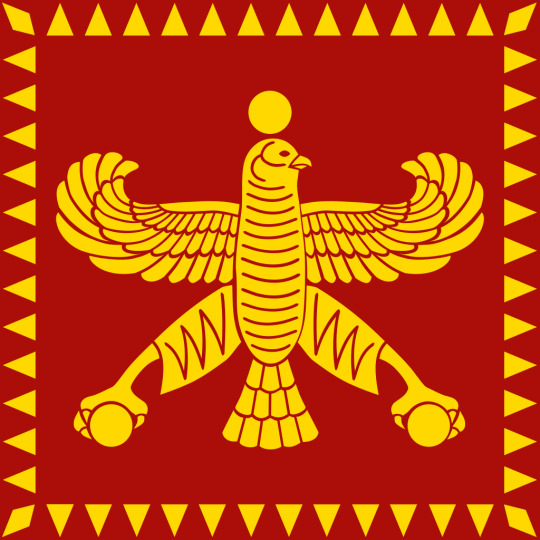
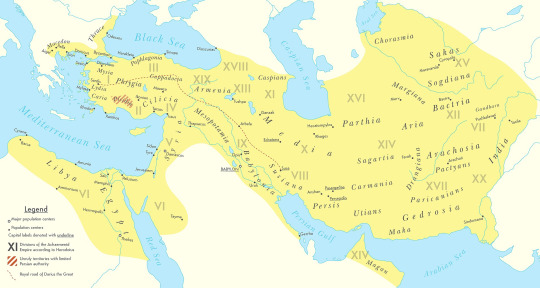


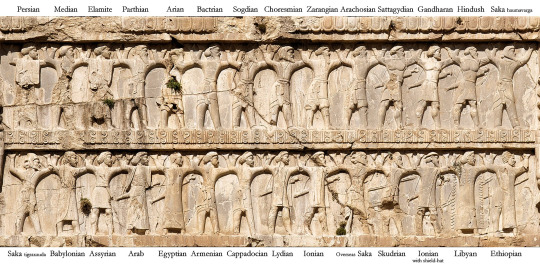
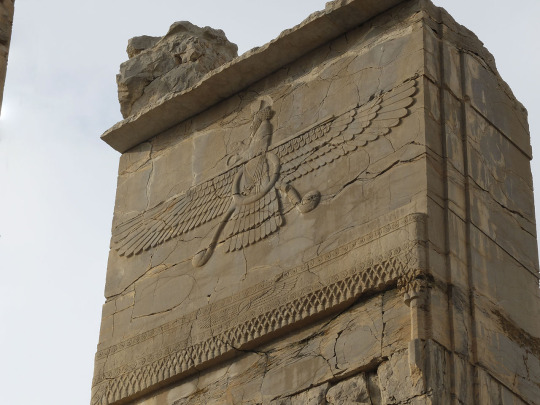




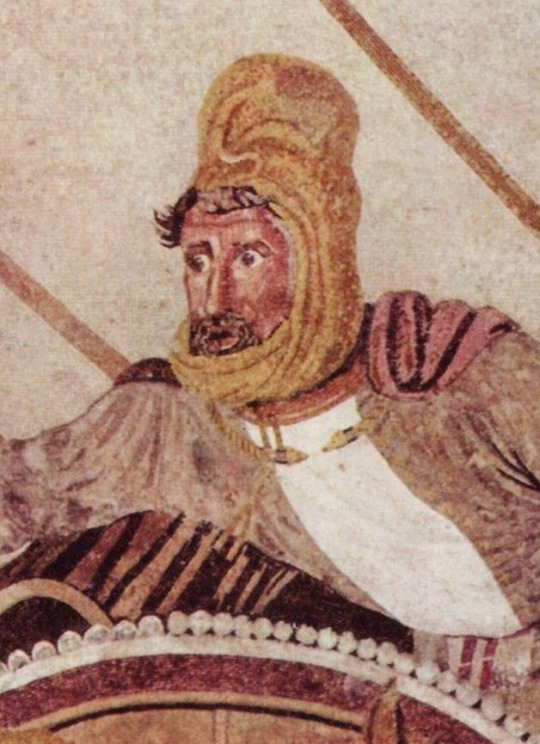
#military history#antiquity#iran#greece#ancient greece#classical greece#ancient ruins#ancient iran#ancient persia#achaemenid#persia#zoroastrianism#alexander the great#cyrus the great#xerxes#artwork#government#history#persian empire#ancient egypt
89 notes
·
View notes
Note
Concerning the ancient sources for Alexander the Great, I noticed you mention time and again many Roman writings, like Arrian. Do we not have any noteworthy Eastern sources dealing with Alexander? - Persian, even if contemporary to Rome, for example? Or from the territories he conquered or fought in
Great question and...alas, not really. See below, but first, here is a collection of pretty much all we have on Persia, by Amelie Kuhrt. It's currently pretty on sale, so grab it now if you want it.

Sources from Achaemenid Persia are few and far between, as much of it didn't survive Alexander (not necessarily intentionally). There are Babylonian and other Mesopotamian chronicles, which are important. We also have the Achaemenid Royal Inscriptions. But the ancient near east didn't write narrative history in the same way Greece and Rome did. Kuhrt discusses ANE traditions in her book.
We also have Indian traditions about him, but these are in languages Classicists rarely/never read, alas. But there has been some important work done on Alexander in Vedic traditions. MORE NEEDS TO BE DONE. We need to be talking more to our Indian colleagues.
Finally, there is work on the archaeology of Central Asia, as well, but the reports are primarily in Russian. Look up material on the Greco-Baktrian Kingdom.
So it's there, but not in the massive amounts we get from the West. The Sasanids do talk about Alexander...and it's not flattering. But we just don't have a lot pre-Sasanid.
#asks#ancient Persia#Achaemenid Persia#ancient Persian sources#Indian sources on Alexander#central Asian archaeology#Greco-Baktrian kingdom#Achaemenid Royal Inscriptions#Babylonian Chronicles#Mesopotamian Chronicles#non-Western sources on Alexander the Great#Alexander the Great#Classics#ANE studies#ancient near east
9 notes
·
View notes
Text

65 notes
·
View notes
Text

~ Clay bulla with impression of a stamp seal depicting the Persian king spearing a Greek hoplite.
Place of origin: Near Eastern, Iranian
Culture: Persian
Period: Achaemenid
Date: 550–331 B.C.
Medium: Clay
#ancient#ancient art#stamp seal#persian#persian king#king#greek hoplite#bulla#clay bulla#achaemenid#iran#iranian#near eastern#persia#550 b.c#331 b.c.#history#archeology#museum#war#battle
259 notes
·
View notes
Text
We do not speak about 484 BC in Northern Babylonia…
#haha… look at all those archives ending#it surely isn’t because some Northern Babylonians were in a revolt#haha… (jk they did and no more archives for them)#achaemenid persia#aubade’s history nerd hour
2 notes
·
View notes
Text

Gate of All Nations
The Gate of Xerxes -UNESCO World Heritage
(r. 486 – 465 BC) Persepolis - IRAN
The bronze trumpets that once signaled the arrival of important foreign delegations to Persepolis, the ceremonial capital of the mighty Achaemenid Empire, may now be silent, but it is still possible to capture the sense of awe while visiting the colossal Gate of Xerxes.
Built during the reign of Achaemenid king Xerxes I , who called this his Gate of All Nations, the pillared entrance is guarded by bearded and hoofed mythical figures in the style of Assyrian gate-guards.
On arrival at Persepolis one is confronted by an imposing wall, completely smooth and plain, about 15 meters tall: this is the artificial terrace on which the palaces were built. This vast terrace of Persepolis, some 450 meters long and 300 meters wide, was originally fortified on three sides by a tall wall. The only access was from the monumental staircase, which leads to the Gate of All Nations.
The gateway bears a cuneiform inscription in Old Persian, Neo-Babylonian, and Elamite languages declaring, among other things, that Xerxes is responsible for the construction of this and many beautiful wonders in Persia. Centuries of graffitists have also left their mark, including explorer Henry Morton Stanley.
A pair of colossal bulls guarded the western entrance; two man-bulls stood at the eastern doorway. Engraved above each of the four colossi is a trilingual inscription attesting to Xerxes having built and completed the gate. The doorway on the south, opening toward the Apadana, is the widest of the three.
According to sources, pivoting devices found on the inner corners of all the doors indicate that they must have had two-leaved doors, which were probably made of wood and covered with sheets of ornamented metal.
Persepolis, also known as Takht-e Jamshid, whose magnificent ruins rest at the foot of Kuh-e Rahmat ("Mountain of Mercy"), was the ceremonial capital of the Achaemenid Empire. It is situated 60 kilometers northeast of the city of Shiraz in Fars Province.
Persepolis was the seat of the government of the Achaemenid Empire, though it was designed primarily to be a showplace and spectacular center for the receptions and festivals of the kings and their empire.
The royal city ranks among the archaeological sites which have no equivalent, considering its unique architecture, urban planning, construction technology, and art.
The city was burnt by Alexander in 330 BC apparently as revenge to the Persians
The immense terrace of Persepolis was begun about 518 BC by Darius the Great, the Achaemenid Empire’s king. On this terrace, successive kings erected a series of architecturally stunning palatial buildings, among them the massive Apadana palace and the Throne Hall (“Hundred-Column Hall”).
This 13-ha ensemble of majestic approaches, monumental stairways, throne rooms (Apadana), reception rooms, and dependencies is classified among the world’s greatest archaeological sites.
#art#design#doorway#architecture#heavensdoorways#gateway#entryway#iran#persepolis#bull#royal#royal city#style#history#gates of xerses#unesco world heritage#monumental#gate of all nations#achaemenid#persia#xerxes#front door#architrave
49 notes
·
View notes